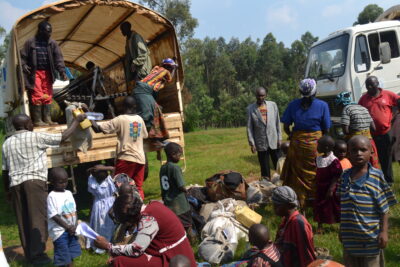Dehumanization. The term is often in the news these days, not least because President Donald Trump frequently issues dehumanizing statements about migrants seeking asylum in the United States. Last May, for example, in a California Sanctuary State Roundtable, Trump conflated undocumented immigrants with members of transnational gangs like MS-13 and declared, “These aren’t people. These are animals.” Throughout his campaign, Trump often referred to immigrants as rapists and criminals. As many have noted, this language follows a long and ugly history of genocidal governments using similar terms to describe unwanted populations: Nazis referred to Jews as rats and vermin. Hutu extremists who organized the Rwandan genocide called Tutsi cockroaches and snakes. Moreover, dehumanization is fourth on the list of the “Ten Stages of Genocide” developed by Professor Gregory Stanton. This stage explains that by equating members of one social group “with animals, vermin, insects, or diseases…. The majority group is taught to regard the other group as less than human, and even alien to their society. They are indoctrinated to believe that ‘We are better off without them.’” Extermination is then only six steps away.
But is it really that simple? Do American citizens, or did non-Jewish Germans, or Hutu Rwandans, simply hear dehumanizing discourse on the radio, or read about it in local newspapers, and change their minds about their neighbors? And concerning the latter two cases, is dehumanizing propaganda what motivated them to kill? Here, I review contemporary research on propaganda and dehumanization, discuss findings from research on the Holocaust and also on the Rwandan genocide, and consider the implications of this work for how violence against civilians becomes normalized.
Dehumanizing propaganda and its impact on genocide
“But this leads to the question, increasingly common in research on dehumanizing propaganda and its impact on genocide, of just how, exactly, dehumanizing discourse enters into the brain and body and reforms social perception.”Dehumanization refers to the act of perceiving victimized subgroups as not completely human. Psychologists distinguish between two types of non-humanness: one that denies uniquely human attributes to others by comparing them to animals (the kind considered here) and one that denies human nature to others by comparing them to objects (also known as objectification and commonly applied, at least in our society, to women).1For a useful review, see Nick Haslam, “Dehumanization: An Integrative Review,” Personality and Social Psychology Review 10, no. 3 (2006): 252–264. Sociologists emphasize that dehumanization is not simply a private belief but a cause and consequence of the importance of social group boundaries. Philosophers, like psychologists, define dehumanization as the relegation of others to the status of nonhuman animals to deprive them of shared moral codes. More recently, social neuroscience provides evidence that dehumanization has cognitive correlates: when people associate others with animals and objects, brain regions implicated in normal social cognition fail to activate. But this leads to the question, increasingly common in research on dehumanizing propaganda and its impact on genocide, of just how, exactly, dehumanizing discourse enters into the brain and body and reforms social perception. While it is true that genocidal governments—and other governments bent on normalizing state violence (e.g., the United States during slavery)—promote images of unwanted populations as animals and objects, such actions tell us little about how they are received by civilians.
Hence, a growing body of research seeks to uncover the mechanisms that link dehumanizing propaganda to civilian participation in genocide. Common to these studies is a focus on exogenous variation, either in media exposure or content, or in patterns of participation in violence. For example, scholars have evaluated the role of Nazi propaganda before and after the establishment of the Third Reich in helping the Nazi party enroll new members, incite anti-Semitic behaviors (such as pogroms during Kristallnacht), and increase denunciations of Jews to authorities. They find that anti-Semitic propaganda had a positive effect where anti-Semitism was historically high, but it had a negative effect where anti-Semitism was historically low, leading them to conclude that the persuasive power of dehumanizing propaganda depends on listeners’ predispositions and serves to amplify existing feelings but not generate new ones. Of note, the authors also find a backlash effect among those who were likely to already disagree with the regime’s anti-Semitic agenda and suggest that hearing Nazi propaganda on the radio might have even caused them to increase their resistance and willingness to protect Jews.2Maja Adena et al., “Radio and the Rise of the Nazis in Prewar Germany,” The Quarterly Journal of Economics 130, no. 4 (2015): 1885–1939.
Similarly, concerning the Rwandan genocide, scholars have sought to examine the precise role of Radio Télévision Libre des Mille Collines (RTLM) in motivating Hutu to kill their Tutsi neighbors. Straus examines the exposure, timing, and content of RTLM broadcasts and finds not only that fewer than 10 percent of Rwandans owned radio transmitters in 1994 but also that broadcast range had little reach in rural areas (approximately 88 percent of the country). Perhaps most importantly, the majority of RTLM broadcasts that called for Hutu to kill Tutsi occurred after the majority of violence had already taken place.3Scott Straus, “What Is the Relationship between Hate Radio and Violence? Rethinking Rwanda’s ‘Radio Machete’,” Politics & Society 35, no. 4 (2007): 609–37. Likewise, Yanagizawa-Drott combines village-level data on participation in the Rwandan genocide with information on local variation in RTLM reception and finds that in the average cell4In Rwanda, each district is divided into sectors, which then further divide into cells and then villages. In short, cells are administrative entities subject to sector authority. that did have reception, only 10 percent of the population received any signals. He concludes that 10 percent of participation in the genocide can be accounted for by radio broadcasts, leaving 90 percent of the violence to be explained.5David Yanagizawa-Drott, “Propaganda and Conflict: Evidence from the Rwandan Genocide,” The Quarterly Journal of Economics 129, no. 4 (2014): 1947–1994. Finally, Danning notes that media availability does not necessarily equate with media consumption. Social practices surrounding media consumption matter as well. In Rwanda, radio is viewed as a community practice and people are most likely to listen in public settings such as bars, on the street, in the market, or at work.6Gordon Danning, “Did Radio RTLM Really Contribute Meaningfully to the Rwandan Genocide?: Using Qualitative Information to Improve Causal Inference from Measures of Media Availability,” Civil Wars 20, no. 4 (2018): 529–554. The result is, despite low levels of reception, RTLM could have had a farther reach during the genocide than its signals can account for or it could have had a lower reach given the disruption to daily life that the genocide caused.
“Dehumanizing propaganda sends signals to people about what they think others believe and, even if they disagree, those perceptions can alter their actions in turn.”In sum, whether in Germany during the Holocaust or Rwanda during the genocide, we still lack clear evidence that dehumanizing propaganda convinced ordinary civilians to change their minds about their neighbors and kill them. Moreover, even in cases where a possible link between broadcast data and participation can be established—the 10 percent identified by Yanagizawa-Drott, for example—it is still unclear what mechanism links dehumanizing propaganda to killing. For example, MacArthur Fellow Betsy Levy Paluck developed an experiment in postgenocide Rwanda where some people heard a radio soap opera about an interethnic relationship where the couple started a peaceful revolution against leaders who sought to sow hate. Others heard a soap opera about health and HIV. She finds that although people didn’t agree with the messages of the former, they were aware of its pro-reconciliation themes and thought others believed it and so they changed their behaviors even if their beliefs stayed the same.7Elizabeth Levy Paluck and Donald P. Green, “Deference, Dissent, and Dispute Resolution: An Experimental Intervention Using Mass Media to Change Norms and Behavior in Rwanda,” American Political Science Review 103, no. 4 (2008): 622–644. It is possible that during genocides a similar mechanism is at work as well. That is, dehumanizing propaganda sends signals to people about what they think others believe and, even if they disagree, those perceptions can alter their actions in turn.
If dehumanizing propaganda doesn’t motivate people to kill, what does?
Research on why people participate in genocide has made leaps and bounds in recent years, especially thanks to the “microlevel turn” in genocide research since the early 2000s. Building on similar research strategies in the scholarship on civil war, microlevel research on genocide focuses on variation in individuals’ motivations and behaviors, and emphasizes that, in any conflict, multiple mechanisms may be at play, motivations can change over time, and the same individual can vary their behaviors from killing to not killing and even saving during a genocide.8→Christopher R. Browning, Ordinary Men: Reserve Police Battalion 101 and the Final Solution in Poland (New York: HarperCollins, 1998).
→Evgeny Finkel and Scott Straus, “Macro, Meso, and Micro Research on Genocide: Gains, Shortcomings, and Future Areas of Inquiry,” Genocide Studies and Prevention 7, no. 1 (2012): 56–67.
→Lee Ann Fujii, Killing Neighbors: Webs of Violence in Rwanda (Ithaca, NY: Cornell University Press, 2009).
→Alexander L. Hinton, Why Did They Kill?: Cambodia in the Shadow of Genocide (Oakland: University of California Press, 2004).
→Aliza Luft, “Toward a Dynamic Theory of Action at the Micro Level of Genocide: Killing, Desistance, and Saving in 1994 Rwanda,” Sociological Theory 33, no 2 (2015):148–72.
→Jared McBride, “Peasants into Perpetrators: The OUN-UPA and the Ethnic Cleansing of Volhynia, 1943–1944,” Slavic Review 75, no. 3 (2016): 630–654.
→Scott Straus, The Order of Genocide: Race, Power, and War in Rwanda (Ithaca, NY: Cornell University Press, 2006). It is therefore impossible to attribute any one motivation to why people kill, let alone to why the same individual kills over time, during a genocide.
That said, important patterns are emerging in identifying the many mechanisms that draw ordinary people into, or away from, genocidal violence. For example, scholarship on the Holocaust, the Rwandan genocide, Cambodia, and other conflicts identify in-group norms and peer pressure as powerful influences on individuals’ decisions to kill. In a now-classic example, Christopher Browning’s analysis of the Nazi Paramilitary Order Police finds that middle-aged family men, responsible for murdering at least 83,000 Jews in Poland, killed more often because of peer pressure and a sense of obedience to authority than any profound commitment to anti-Semitism.9Browning, Ordinary Men. Similarly, Scott Straus’s study of civilian participation in the Rwandan genocide finds that individuals’ decisions to kill were often the result of “face-to-face mobilization: individuals, leaders, or groups directly solicited…at commercial centers, on roads and pathways, or at their homes.”10Straus, The Order of Genocide. Yet other work finds that inequality channels participation in violence through greed or grievance, and also that people with less economic capital have fewer opportunities to resist extremists’ coercion.11→Paul Collier and Anke Hoeffler,” On Economic Causes of Civil War,” Oxford Economic Papers 50, no. 4 (1998): 563–73.
→Luft, “Toward a Dynamic Theory of Action at the Micro Level of Genocide.” The classic “obedience to authority” thesis developed originally by Stanley Milgram has found renewed support in microlevel research on genocide as well: besides Browning and Straus, who both find hierarchical pressures mattered in motivating participation, Williams interviews former Khmer Rouge who explain their participation primarily as the result of vertical coercion.12Timothy Williams and Rhiannon Neilsen, “‘They Will Rot the Society, Rot the Party, and Rot the Army’*: Toxification as an Ideology and Motivation for Perpetrating Violence in the Khmer Rouge Genocide?” Terrorism and Political Violence, October 14, 2016, 1–22.
A full review of all the scholarship on civilian mobilization for genocidal violence is beyond the scope of this essay, but, suffice it to say, this is a dynamic time for social scientific research on genocide as old assumptions are either being challenged, complicated, or extended with new data and via new methodical strategies all the time.
Does this mean dehumanization doesn’t matter?
“Extreme perspectives can become normalized when dehumanization becomes central to political discourse.”Of course not. Rather, contemporary research on genocide is striving to understand precisely how dehumanizing discourse matters in light of the findings discussed above. One possibility, as mentioned above, is that dehumanizing propaganda can alter common perceptions of others’ beliefs, compelling those who might dissent to hesitate to speak out. Even if people do not believe what they hear on the radio, dehumanizing propaganda can increase the perceived risks of verbal and behavioral disagreement with extremists. Alternatively, dehumanizing propaganda can persuade some with already-negative perceptions of others to act violently and then trigger a contagion effect whereby, as a result of social interactions, these people then motivate others to join.13Indeed, this is one of Yanagizawa-Drott’s main findings about militia violence in Rwanda. Yanagizawa-Drott, “Propaganda and Conflict.” Dehumanizing propaganda can also, quite simply, grant legitimacy to those who put forth violent solutions to social problems, even if it doesn’t convince all listeners. Extreme perspectives can become normalized when dehumanization becomes central to political discourse.
Finally, in my own research, I find that dehumanization is more often an outcome of participation in violence rather than a precursor.14Luft, “Toward a Dynamic Theory of Action at the Micro Level of Genocide.” In other words, people make difficult decisions about whether or not to participate in genocide based on their access to financial resources, who they’re being asked to kill, their proximity to extremists ordering the violence, and signals sent by local elites. But the more they kill, the easier killing becomes, and this is partly due to shifts in social perception. Although participants in genocide describe reactions that include vomiting, shaking, nightmares, and trauma the first few times they kill, over time, their physical and emotional horror at killing subsides. My research suggests this cognitive adaptation to violence goes hand-in-hand with a transformation in how ordinary killers perceive their victims. Dehumanizing propaganda can help with this process by providing participants with cultural narratives that frame violence as the morally right thing to do, and it can help them overcome their initial resistance to killing neighbors as a result.
Implications
The implications of the review and arguments provided here are not that we shouldn’t care when political leaders, elites, and media propagate dehumanizing discourse. My point is that dehumanizing propaganda rarely leads to genocide on its own—a common misconception often asserted by those who wish to decry the violence of such language. This is good. It means that anytime we hear dehumanizing discourse in the media, there is still time to intervene, to promote alternative narratives, and to counter leaders who wish to mobilize their constituents for violence by organizing resistance. If the link between dehumanizing propaganda and genocide were direct, none of this would be possible. In contrast, anytime a member of the Trump administration, media pundit, or political commentator uses dehumanizing language, there is an opportunity for others, especially those of similar status who can affect public opinion, to object.
On the other hand, and quite sadly, the evidence above also suggests that dehumanizing language is not necessary for mass violence and genocide to transpire. Moreover, whether or not the president calls immigrants animals or rapists, and whether or not the majority of the country agrees with him (they don’t), immigrant children are currently being separated from their parents and siblings at the border, detained in concentration camps, and subjected to physical and sexual abuse by US authorities. Dehumanizing discourse can pave the way for violence to occur, but violence does not require it.15For a similar argument, see Aliza Luft and Daniel Solomon, “How Dangerous Is It When Trump Calls Some Immigrants ‘Animals’?” Monkey Cage (blog), Washington Post, May 25, 2018.
References:
→Evgeny Finkel and Scott Straus, “Macro, Meso, and Micro Research on Genocide: Gains, Shortcomings, and Future Areas of Inquiry,” Genocide Studies and Prevention 7, no. 1 (2012): 56–67.
→Lee Ann Fujii, Killing Neighbors: Webs of Violence in Rwanda (Ithaca, NY: Cornell University Press, 2009).
→Alexander L. Hinton, Why Did They Kill?: Cambodia in the Shadow of Genocide (Oakland: University of California Press, 2004).
→Aliza Luft, “Toward a Dynamic Theory of Action at the Micro Level of Genocide: Killing, Desistance, and Saving in 1994 Rwanda,” Sociological Theory 33, no 2 (2015):148–72.
→Jared McBride, “Peasants into Perpetrators: The OUN-UPA and the Ethnic Cleansing of Volhynia, 1943–1944,” Slavic Review 75, no. 3 (2016): 630–654.
→Scott Straus, The Order of Genocide: Race, Power, and War in Rwanda (Ithaca, NY: Cornell University Press, 2006).
→Luft, “Toward a Dynamic Theory of Action at the Micro Level of Genocide.”














Pingback: On VTV’s Dehumanizing statement  – minhthi
Pingback: CAN BIDEN AVOID THE THUCYDIDEDES TRAP WHILE A RACE WAR RAGES IN THE USA? | marygravitt